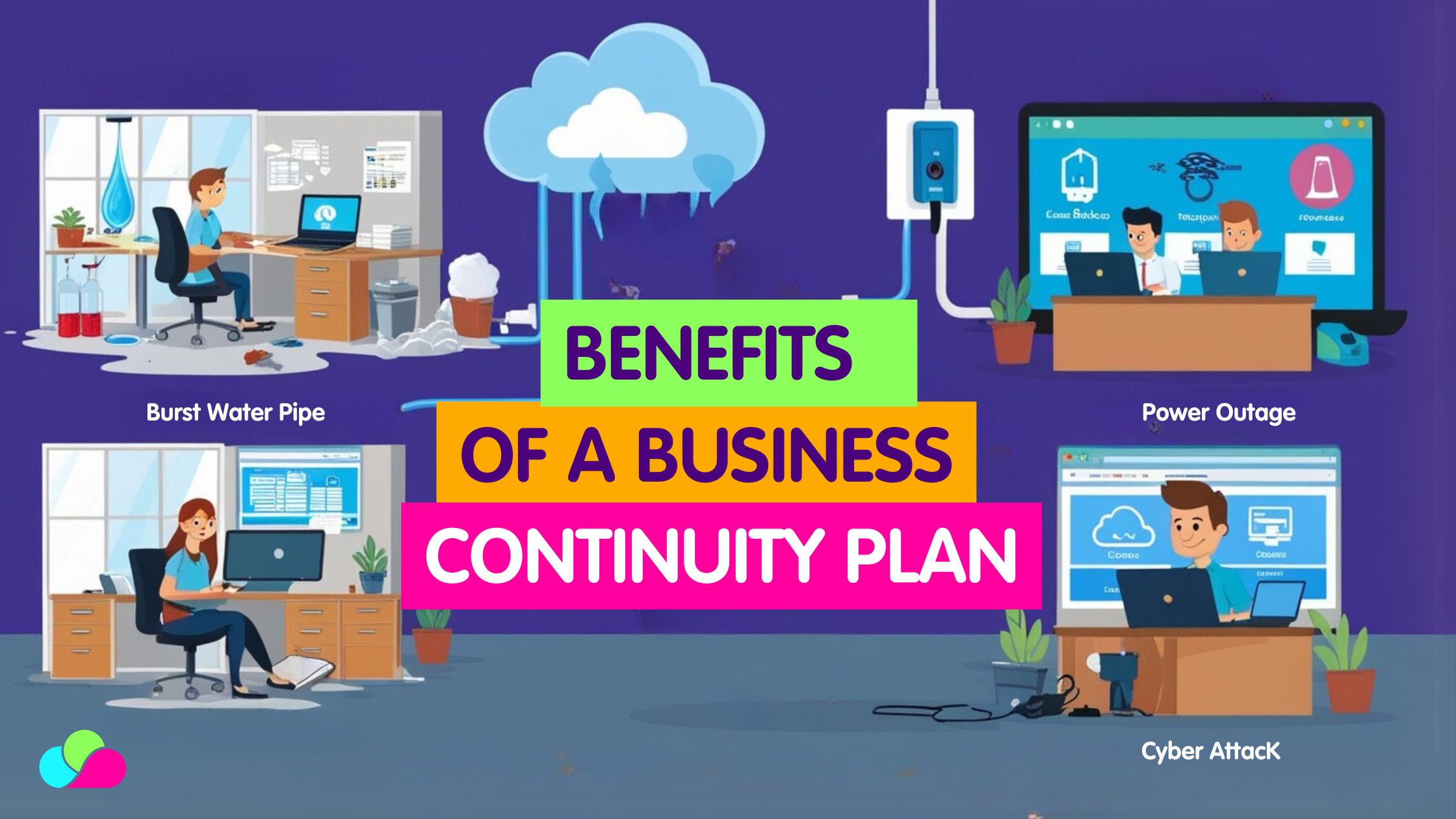Let’s face it, life loves to throw curveballs—whether it’s a cyber attack, a burst water pipe, or that one colleague who accidentally unplugs the server (again). For businesses, these disruptions can be more than just inconvenient, they can be downright costly.
At Cloud & More, we’ve seen firsthand how quickly an unexpected event can spiral without a plan in place. A burst pipe in one client’s office led to a full day of downtime because their backups were stored in the same building. It was a lesson they never want to repeat, and neither should you.
That’s where a business continuity plan swoops in like a superhero in sensible shoes. It helps your business prepare for the unexpected, recover faster, and keep things running smoothly, even when everything seems to be going wrong. Here’s why it’s a must-have:
1. Minimise downtime and protect operations
Disruptions can stop your business in its tracks faster than the office Wi-Fi going down on a Monday morning. A continuity plan keeps things moving, no matter what’s happening behind the scenes.
How it helps:
- Identifies essential business functions (like keeping the coffee machine running).
- Ensures access to key systems and data during downtime.
- Provides step-by-step instructions for maintaining operations.
Cloud & More Insight: One of our clients avoided a complete shutdown during a power outage thanks to their plan. With their team working remotely on cloud-hosted systems, they barely missed a beat.
2. Safeguard sensitive business data
Data breaches and hardware failures are the stuff of nightmares (right up there with “reply all” email mishaps). A continuity plan ensures your data stays safe and sound.
Key elements:
- Regular, automated backups—because we all know “I thought I saved it” isn’t a strategy.
- Fast recovery options to get you back on track quicker than you can say “forgotten password.”
- Strategies to keep your data safe from cyber villains and the dreaded coffee spill.
3. Build trust with clients and stakeholders
Clients like businesses they can rely on, just like you like your favourite takeaway to deliver on time. A continuity plan shows you’ve got things under control, no matter what.
Why it matters:
- Builds confidence in your ability to deliver (even during a power cut).
- Strengthens relationships by showing you’re prepared for anything.
- Keeps your reputation intact, so no one’s left wondering if you’ve gone offline for good.
Cloud & More Insight: We once supported a business that had to call clients mid-outage to reassure them everything was under control. Because they’d planned ahead, they could confidently share timelines for getting back online—and didn’t lose a single customer.
4. Stay compliant with regulations
Let’s be honest, no one wants to deal with fines or sternly worded letters from regulators. A continuity plan ensures you tick all the boxes and avoid awkward conversations.
Examples of compliance requirements:
- GDPR loves a good data protection strategy.
- Cyber Essentials certification includes continuity planning (and bonus points for being extra organised).
5. Save money with a proactive approach
Think of a continuity plan as the business equivalent of insurance—minus the “wait, do I really need this?” moment. It saves you money and stress when things go sideways.
Cost-saving benefits:
- Avoid lost revenue from downtime (and the resulting panic).
- Reduce emergency recovery expenses because hiring a last-minute “IT guru” isn’t cheap.
- Stay compliant and avoid fines, keeping your accountant happy.
Prepare your business for the unexpected
A business continuity plan is like having an umbrella on a sunny day, sure, you might not need it now, but when the storm hits, you’ll be glad you have it. By planning ahead, you can protect your operations, data, and reputation while keeping your clients happy.
At Cloud & More, we make continuity planning personal, practical, and surprisingly painless. Contact us today to start preparing for whatever comes your way.
Ready to make 2025 the year of cyber security success?
Secure your businesses future with a tailored business continuity plan. Contact Cloud & More now and let’s keep your business running, no matter what comes your way.

FAQs
What is a business continuity plan
What is a business continuity plan?
A business continuity plan (BCP) is a strategy that outlines how a business will continue operating during an unplanned disruption or emergency. It’s like a “what-if” guide that helps your team know what to do if things go wrong—whether it’s a cyber attack, a power outage, a natural disaster, or even something like a pandemic.
In simple terms:
It’s your plan B. But properly thought through, tested, and ready to go.
What’s usually included in a BCP?
Risk assessment
What could go wrong? Identify potential threats to your business operations.
Impact analysis
What would happen if those risks occurred? This helps prioritise planning.
Critical business functions
What do you have to keep running to stay operational?
Recovery strategies
How will you restore operations if a disruption happens?
Communication plans
Who needs to know what, and how will you tell them? Keep everyone in the loop.
Roles and responsibilities
Who’s doing what during a crisis? Clear roles speed up response times.
Backup and recovery procedures
Steps to protect and restore systems, data, staff, and supplier relationships.
Why does it matter?
Because downtime = lost money, lost trust, and (potentially) lost clients.
A solid BCP helps you stay calm and act quickly when chaos hits, reducing damage and helping your business bounce back faster.
How does a business continuity plan relate to IT support?
A BCP ensures your IT systems are prepared for disruptions—like server crashes, ransomware, or internet outages. It outlines how your team can access systems, restore backups, and stay connected so the business can keep moving even when tech fails.
What’s the difference between a business continuity plan and a disaster recovery plan?
A business continuity plan covers the whole business, including communication, operations, and people. A disaster recovery plan (DRP) is a subset that focuses specifically on restoring IT systems and data after a crisis.
How can a business continuity plan help protect against cyber attacks?
While a business continuity plan won’t stop a cyber attack, it ensures you have a step-by-step plan to minimise downtime, isolate infected systems, notify the right people, and recover safely from backup. It turns chaos into action.
Does a business continuity plan include cloud and remote working solutions?
It should. Modern BCPs consider how your team can access critical systems remotely, use cloud-based backups, and maintain secure communication from anywhere. This became vital during the pandemic and is now a must-have for hybrid workforces.
Who should be involved in creating a BCP for IT and cyber security?
Your IT team or provider, leadership team, and any third-party vendors (like cloud providers or cyber security consultants) should all contribute. It’s not just about writing a document—it’s about making sure the plan actually works in practice.




